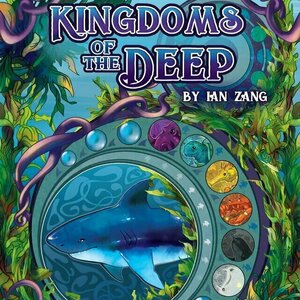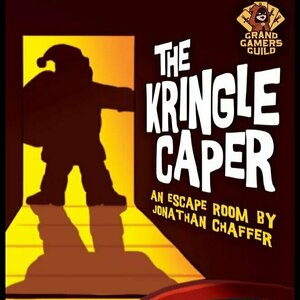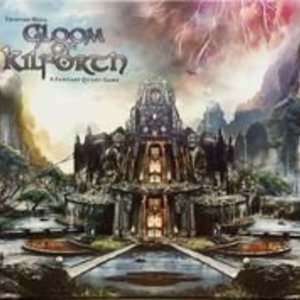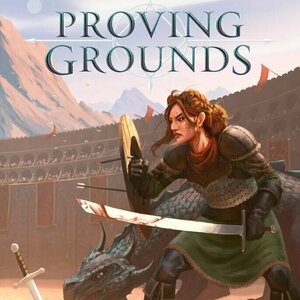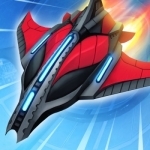
Air Race Speed
Games and Entertainment
App
“Speeding is tons of fun, especially with no cops around” - Pixelated Sausage Take speed to a...
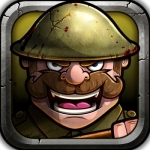
Trenches II
Games and Entertainment
App
DIG FOR VICTORY! TRENCHES II wants you to join the fight! Wage a whole new war, as the Russians join...
Purple Phoenix Games (2266 KP) rated Kingdoms of the Deep in Tabletop Games
Dec 26, 2020
Kingdoms of the Deep is an abstracted area-control game set in the ocean for one to six players. In it players lead a faction of creatures intent on ruling the underwater kingdom. The player who scores the most VP at the end of the game is the winner, and as their king the player must rule with a strong pectoral fin. Okay, that last part isn’t in the rules, but it should be.
DISCLAIMER: We were provided a prototype copy of this game for the purposes of this preview. These are preview copy components, and the final components may be different from these shown. Also, it is not my intention to detail every rule in the game, but to give our readers an idea of how the game plays. You are invited to back the game on Kickstarter launching January 12, 2021, order from your FLGS, or purchase through any retailers stocking it after it is fulfilled. -T
To setup players will choose a color and take all components of that color. Obviously, the best choice is purple. Next the central board will be built of large hex tiles surrounding an Atlantis tile. Upon Atlantis one Shark token will be placed. The Score Board is placed near the central hex board and upon it is placed the Round Marker, the End Game Scoring tile, and the three Goal cards. Players then populate the board with their Influence Cubes on their specific preferred terrain types. Upgrade Cubes (discs in the final version) are then placed on each player’s individual play mats on the furthest value to the left, save for the Reset upgrades: players will choose one to place a cube. Give the starting player the Start Player token (a manta ray in this prototype) and the game may begin!
On a turn each player will choose a card from their hand of Action cards to be flipped simultaneously. The starting player will resolve their card first and play will continue around the table thenceforth. Each player will take their action and prepare for the next round. Should a player choose a card that no other player had chosen for the round they will also be able to activate the Solo Ability printed on the card. Typically these Solo Abilities are a furtherance of the action chosen. For example, should a player choose the Deploy Action card and be the only one to do so, they will be able to deploy one additional Influence Cube on the board than normal. The actions are Bolster, Deploy, Move, Upgrade, Shark, and Reset. Each action is limited to a number of cubes added, spaces moved, or upgrades allowed according to where the player board discs (large cubes in the prototype) lie on the player’s mat.
The Bolster action allows the player to add a number of Influence Cubes to the board on the player’s current preferred terrain type. To Deploy units is to add Influence Cubes to the board on hexes already containing their Influence or hexes directly adjacent to those already containing their Influence cubes. When a player chooses the Move action they are able to move creatures (Influence Cubes of any player and Shark tokens) a number of spaces that can be used for once creature or split between several. Players will certainly wish to Upgrade their actions throughout the game by increasing their player board discs’ spaces on their mat. For example, upgrading the Move action could allow the player to move creatures three spaces instead of two. The Shark action allows the player to move the Shark token(s) and chomp creatures on the same hex. Once a Shark feeds, the controlling player will increase their standing on their own Bait Pile track on their play mat. Certain increments on this track will provide the player with one instance of an action (Move, Deploy, etc), and the creature’s Influence Cube is returned to the matching player. Reset actions allow the player to recall their played Action cards to their hands, but also provide whichever action the player originally chose at setup. Should a player wish to Upgrade their Reset action more actions will become available to them each time they utilize the Reset action. Additionally, at the end of the player’s turn having used the Reset action card the Round Marker token is moved one space closer to the end of the game on its track. More on this later.
During play, some creatures may be moved onto the Atlantis tile in the middle of the board via the Deploy or Move actions. When this happens the player who moved the cube onto the Atlantis tile will score a point immediately, and the creature cube is placed in the Atlantis castle (cloth bag in the prototype, but a castle component in the final version). At the end of the game points are awarded to the player with the most creatures in Atlantis.
Every three movements of the Round Marker token signifies a scoring round takes place. Players will consult the current Goal card for any scoring round bonuses and points are earned. The Goal card is then discarded to reveal the next Goal card in sequence on which players can concentrate during the next rounds of play. Also during the first two of these scoring rounds another Shark token is added to the board on the Atlantis tile to be moved around seeking lunch. Once the Round Marker reaches the final scoring round the game ends and points are tallied to arrive at the winner.
Components. Again, this is a prototype version of the game, and while I know certain things will be different in the final version, I do not know what else may be upgraded as a result of any stretch goals reached. Therefore I do not want to comment on the quality of the components, but rather the art style and direction this game is heading toward actual production.
The art on this one is simply gorgeous. The style is the same as that of Animal Kingdoms, which is also a release from Galactic Raptor. All the art I have seen in this game is sublime and permeates the theme into every portion of the game. It is so beautifully colorful and the creatures are all unique and interesting that it may be difficult to concentrate on the actual game for some people, I imagine.
All that aside, I really do think this is a good game. It certainly gives me the Witch’s Brew/Broom Service vibe with benefits for the player who chooses something the others have not. Combine that feeling with that of the chaos of Survive!: Escape from Atlantis area control of constantly-shifting cube placement and I think Galactic Raptor has a hit here. Again, I am excited to see the final product with the more premium components and tweaked rules, but what I have here is still a good implementation of the mechanics with a hard-to-beat theme.
I do quite like the Shark ability to chomp not only everyone else’s creatures, but also your own to take those cubes back into your supply to be Bolstered or Deployed elsewhere. I also really like being able to Upgrade any action I wish to truly personalize my style and tactics during play. I like being able to Move other players’ creatures into Atlantis for that immediate point, but also to remove that cube from play altogether. It creates quite an interesting dynamic and strategy to facilitate other players’ majority status in Atlantis in order to gain quick points and board control right away. There are so many thing to like about this game, and I am so glad I was able to give it a chance on the table.
If you enjoy games similar to those I mentioned previously, then check out Kingdoms of the Deep. It is beautiful, offers quite a bit of strategy and tactics, and stands to become an excellent mid-weight simultaneous action, area control game WITH SHARKS. While I probably won’t be playing this one every game night, I can certainly see myself introducing it to many of my fellow gamers. I urge you to check out the Kickstarter campaign for Kingdoms of the Deep once it launches in January. Tell ’em Old Travis sent ya.
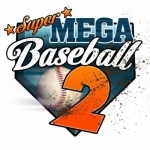
Super Mega Baseball 2
Video Game Watch
The critically acclaimed, streamlined baseball simulator is headed for second. Lace up your cleats...
sports simulation
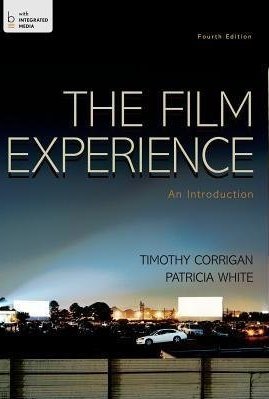
The Film Experience: An Introduction
Book
In our culture, watching movies is a universal experience – but understanding film may not be. The...

Choices of One (Star Wars Legends)
Book
From #1 New York Times bestselling author Timothy Zahn comes a brand-new Star Wars adventure, set in...
Purple Phoenix Games (2266 KP) rated The Kringle Caper in Tabletop Games
Dec 18, 2021
The Kringle Caper is a Christmas-themed escape room type card game. It consists of 18 cards and I found it much more difficult than its sibling, The Independence Incident, which I reviewed in July.
DISCLAIMER: We were provided a copy of this game for the purposes of this review. This is a retail copy of the game, so what you see in these photos is exactly what would be received in your box. I do not intend to cover every single rule included in the rulebook (as there is none), but will describe the overall game flow and major rule set so that our readers may get a sense of how the game plays. For more in depth rules, you may purchase from your FLGS. -T
To setup, open the flaps of the box containing the cards, navigate to the provided website to launch a web-based companion app, and the game may officially begin!
As I do not wish to spoil anything about the game, I will merely state here that following directions, completing puzzles, and knowing a little something about the Christmas holiday will benefit players immensely. Sorry I cannot say more, I would rather you all experience it for yourselves.
Components. This game consists of 18 double-sided cards and a nifty little box to hold it all. The cards are all nice quality, and feature very specific artwork on them. I have no complaints about the components at all here. Grand Gamers Guild always provide great quality games.
Ok, be mad at me if you like, but I just cannot bring myself to go into great detail about the game mechanics, how to play, or what is really included. Just know that this is probably a game you will play once and pass along, or keep several years between plays so that it doesn’t become too repetitive and easy to solve.
I know reviews like these could be considered a cash grab normally, but we don’t accept payment for any of our reviews, so I will use this section to lay out what I like and what I do not like about this installment. I just love the idea of these types of games: small decks that provide so many decisions to be made, or puzzles to solve, and riddles to mull over. Personally, I prefer The Independence Incident, but not because I think this version is weaker, but rather because I was much more successful solving the cards by myself. It is difficult to recruit some of the gamers in my life to play these types of games, so if it can be played solo, that’s the option I will take. That said, I’m sure most people enjoy things more if they are inherently good at them, and such is the case for my preference between the two. That said, Purple Phoenix Games gives this one a festive, but sneaky, 4 / 6. I am glad to have played it, and look forward to passing it along to someone else who has yet to enjoy it.
I will say that I believe all gamers should try both versions, and I am excited to find and try the Halloween and Valentine’s Day versions as well. If you also enjoy these quick escape-room-style card games, give this one a shot, but please promise me you will also try the others as well. Now get out there and solve this mystery, little elf!
Paul Kellett (118 KP) rated Gloom of Kilforth: A Fantasy Quest Game in Tabletop Games
May 1, 2019
You start by choosing a character, class and a saga to tell. Your character and class give you your starting stats (combat, knowledge, sneak and influence) while the sagas are 4 chapters long and each chapter requires 2 (or 3 if only playing 1-2 players) keywords to complete. Completing a chapter levels up your character giving you more health and a new skill.
Keywords are found on the cards you encounter as you search the map and are colour coded to give you a hint to where they are most likely to be found.
The map is a 5x5 grid of cards with Sprawl City in the centre and a mix of Forests, Mountains, Plains and Badlands arranged randomly around it.
Every time you enter an empty location, you draw a card from the relevant terrain deck and interact with it.
Encounters are won by rolling a number of d6 dice equal to your skill in the stat list d on the encounter. Success is on a 5 or 6 so playing to your character's strengths is paramount.
Each player starts with 4 health and at the start of each round, you gain action points equal to your current health which makes strategy and stealth the key to early success.
It also means that the game starts slowly but starts to snowball as you complete the chapters of your saga and level up.
At the end of each round, you make camp and draw a night card which causes a location to fall into gloom and possibly trigger an event. A character ending the day on a gloom location will suffer 1 health point loss.
This is the game timer, so you have 25 days to complete your saga, gain more skills and equipment and confront the big bad.
Despite the random encounter draws and the size of each terrain deck (30+ cards each), every card has been carefully designed to fit into the game and let you narrate a unique story as you play.
If you want a unique narrative adventure game with a solid depth of strategy, look no further.

A Pocket of Wind Resistance by Karine Polwart
Album Watch
The first studio album from the acclaimed Karine Polwart in over 5 years. A Pocket Of Wind...
pop folk
Purple Phoenix Games (2266 KP) rated Proving Grounds in Tabletop Games
Aug 23, 2021
Proving Grounds is a solo fighting dice game with real-time phases. Players will win by defeating eight opponents in battle and will lose (often, in my case) if the heroine suffers too many wounds. The game is played over several rounds, and Renegade has provided an app to act as a timer during the rolling dice phase. Obviously I am terrible at the game, but how does it play and do I feel like continuing to suffer subsequent losses?
To setup a basic game, place the Encounter Board in the middle of the table. Shuffle the enemy cards (with swords & board backs) and deal one per slot around the Encounter Board. These are the first set of enemies Maia will be fighting. Place Battle Markers (silver ninja stars that track wounds inflicted to enemies) in the outlined spaces of the enemy cards. Place Maia’s health token (a heart) on the tracker and one each of the green, yellow, and blue dice on the health area in the space with a rainbow surround. Fill the exhaustion track with one white die per space (on the right side of the Encounter Board), and take the rest of the dice into hand to use as the dice pool. For this review I also used the Dragonling Die module.
As mentioned, Proving Grounds is played solo over a series of rounds. Each round consists of three phases: Roll Dice, Resolve Attacks, and Recover. The first phase of the game, Roll Dice, is also the most chaotic. During this phase the app timer (or your phone or sand timer or sun dial) will allow 60 seconds to roll the dice and arrive at a final result. The interesting aspect of this mechanic at play here is that only sets of dice may be rerolled, not singles. So players may only roll that set of four 3s and not the solitary 1 sitting there all alone. This causes some brain freeze because many games utilize this in reverse, where only singles may be rerolled. Factor that into a 60 second frenzy to get the greatest results and brains will smoke.
Once the timer is up or players are satisfied with the rolled results, they move to the next phase: Resolve Attacks. Each number rolled on the dice correspond to the enemy’s position around the Encounter Board. So that solitary 1 that was rolled earlier is assigned to the enemy in position #1. Here’s the kick in the rear though: any single dice assigned to an enemy will result in a wound dealt to Maia, and would require the player to sacrifice one of the dice to the exhaustion track! Should an enemy require three or more dice but only two are assigned, or if zero dice are assigned, nothing happens to Maia nor the enemy. But those dang single dice will come back to haunt the player. A lot, if they play like I do. Some enemies will require at least one of the dice to be the blue/green/yellow die in order to be successful while others are just straight number of dice. Calculating everything that is needed during the Roll Dice phase is something that I have yet to master.
After attacks are resolved, players enter the Recover phase. During this phase players will gather all assigned dice from the round as well as any dice on the lowest spot of the exhaustion track to be used for the next round. Any enemies that were defeated have left an empty slot on the Encounter Board, so a new enemy will now fill that void. Play continues in this fashion of three phases per round until either eight enemies have been defeated or Maia suffers too many wounds to continue.
Components. I am fascinated by how few components are needed to put a game like this together. Yes, the Encounter Board is mostly unnecessary, but a great way to organize the game and keep everything spacially relevant for those of us that need that. The cards are fine quality and the game has great art. The dice are very cool, but I am unsure how the colors pop for our colorblind gamer friends. While the game doesn’t necessarily refer to the damage markers as “ninja stars” I cannot get over the fact that they are ninja stars. They are certainly out of place in a game like this where I encountered zero ninjas in my plays. Everything else, though, is great and it comes in a nice-sized box: a little smaller than my Century: Golem Edition box.
It was Kane Klenko’s birthday recently, so I wished him a happy birthday on social media and informed him that I was celebrating by playing Proving Grounds. His response was absolutely perfect: “Good luck!” Well, Kane, I never have good luck with this one! It is certainly a combination of poor dice rolling, poor decision making whilst rolling dice, and just dumb luck (emphasis on dumb). I love playing this game but it is infuriating that I have yet to beat it! Even with just the first Dragonling Die module! Gahhhhhh!!!
However, Proving Grounds is an excellent dice game that breaks out of the Yahtzee clone mold and into something fresh and exciting. The twist of only being able to reroll sets instead of singles makes for interesting decisions when you really need to defeat enemy #5 but just cannot roll ANY 5s to save your life (in the game). I just want to beat it once with the Dragonling Die so I can start adding in other modules (oh yes, there are several other modules to add). When games force me to WANT to play them more and more, even for the sheer hope of victory, I consider that a mark of distinction and a sign of a great game.
So if you are like me and enjoy the pain of defeat over and over again then I invite you to try Proving Grounds. It will not be easy. But if you happen to beat it, especially on your first try, please let me know. I need all the cheat codes I can get here. It will stay in my collection probably forever because I just need to overcome it, and then once I figure it out completely, I will just need to wallop it over and over to teach it a lesson. Enjoy Proving Grounds everyone!
